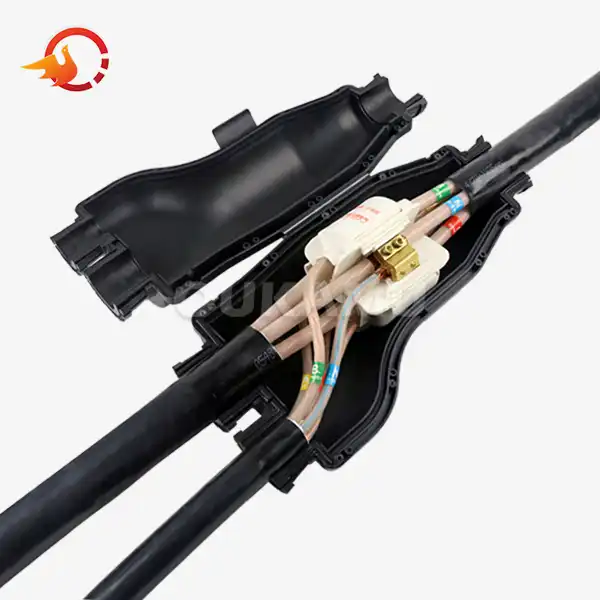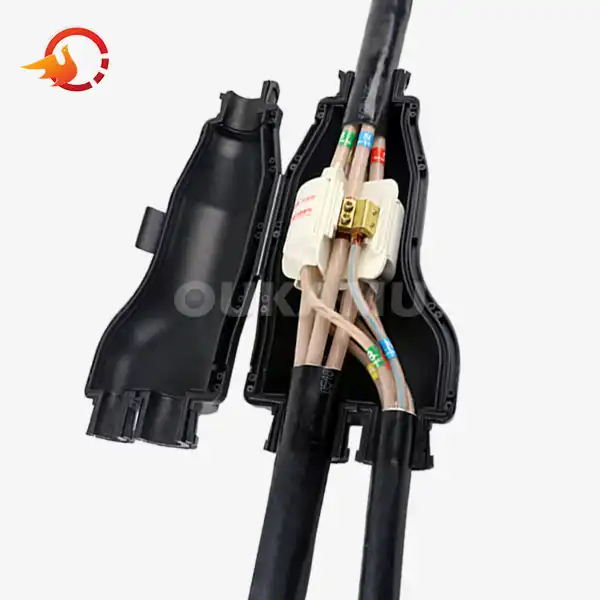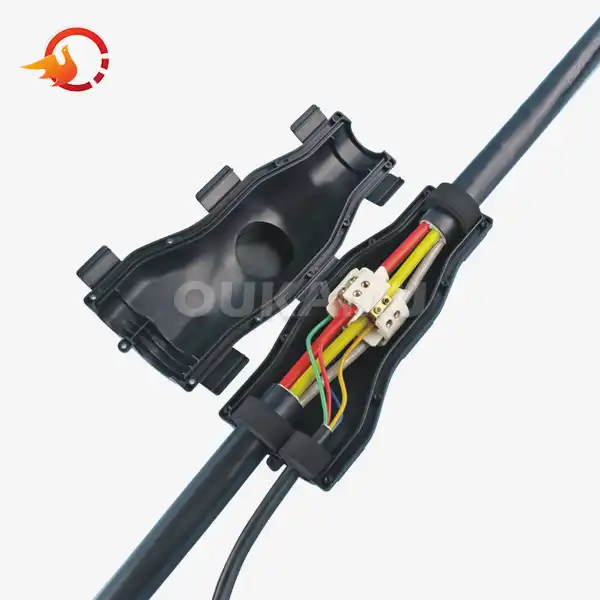The Importance of Proper Sealing in Underground Cable Joints
 2025-08-08 07:25:24
View:389
2025-08-08 07:25:24
View:389Underground cable joints play a crucial role in maintaining the integrity and efficiency of electrical distribution systems. These joints are the connective tissue of our underground power infrastructure, linking cables and ensuring the seamless flow of electricity. However, their effectiveness hinges on one critical factor: proper sealing. In this comprehensive guide, we'll explore why proper sealing is paramount for underground cable joints and how it impacts the overall performance and longevity of electrical systems.
The Basics of Underground Cable Joints
Before delving into the importance of sealing, it's essential to grasp the fundamentals of underground cable joints. These specialized components are designed to connect two or more cables underground, creating a continuous electrical path. They're used in various applications, from residential power distribution to large-scale industrial installations.
Types of Underground Cable Joints
Several types of underground cable joints exist, each suited for specific applications:
- Straight joints: Used to connect two cables in a straight line
- Branch joints: Allow for the creation of T-connections or multiple branches from a main cable
- Transition joints: Connect cables of different types or sizes
- Stop ends: Seal the end of a cable to prevent moisture ingress
Regardless of the type, all underground cable joints share a common need for robust sealing to ensure their longevity and performance.
Components of a Typical Underground Cable Joint
An underground cable joint typically consists of several key components:
- Conductor connectors: Join the individual conductors of the cables
- Insulation: Provides electrical isolation between conductors
- Outer sheath: Protects the joint from mechanical damage
- Sealing system: Prevents moisture and contaminants from entering the joint
The sealing system is arguably the most critical component, as it safeguards the entire joint against environmental threats.
The Critical Role of Proper Sealing in Underground Cable Joints
Proper sealing is not just a minor detail in the construction of underground cable joints; it's a fundamental aspect that determines the joint's effectiveness and longevity. Let's explore why sealing is so crucial.
Protection Against Moisture Ingress
One of the primary functions of proper sealing is to prevent moisture from entering the cable joint. Underground environments are often damp, with water from rain, groundwater, or flooding posing a constant threat. When moisture penetrates a cable joint, it can lead to:
- Corrosion of metal components
- Degradation of insulation materials
- Electrical tracking and partial discharge
- Short circuits and system failures
A well-sealed joint acts as a barrier, keeping the internal components dry and functioning as intended.
Shielding from Environmental Contaminants
Underground cable joints are exposed to various environmental contaminants, including:
- Soil particles
- Chemical agents in the ground
- Microorganisms that can degrade materials
- Gases that may corrode or react with joint components
Proper sealing creates a protective envelope around the joint, preventing these contaminants from compromising the electrical connection or damaging the joint's internal components.
Maintaining Electrical Integrity
The primary purpose of an underground cable joint is to maintain electrical continuity. Proper sealing ensures that the electrical integrity of the joint remains intact by:
- Preventing air gaps that could lead to partial discharge
- Maintaining consistent insulation levels
- Avoiding the creation of conductive paths that could cause short circuits
- Ensuring the stability of electrical connections over time
Without adequate sealing, the electrical performance of the joint can deteriorate rapidly, leading to system instability and potential failures.
Consequences of Inadequate Sealing in Underground Cable Joints
The repercussions of poor sealing in underground cable joints can be severe and far-reaching. Understanding these consequences underscores the importance of investing in proper sealing techniques and materials.
Premature Joint Failure
Inadequately sealed joints are prone to premature failure. This can manifest in several ways:
- Electrical breakdown due to moisture ingress
- Mechanical failure caused by corrosion or material degradation
- Insulation failure leading to short circuits
- Thermal runaway resulting from increased resistance at connection points
These failures not only disrupt power supply but can also pose significant safety risks to personnel and property.
Increased Maintenance and Replacement Costs
Poorly sealed joints require more frequent maintenance and often need premature replacement. This leads to:
- Higher operational costs for utilities and service providers
- Increased downtime during repairs and replacements
- Additional labor costs for emergency repairs
- Potential fines or penalties for service interruptions
Investing in proper sealing from the outset can significantly reduce these long-term costs.
Compromised System Reliability
The reliability of an entire electrical distribution system can be compromised by a single poorly sealed joint. This can result in:
- Frequent power outages
- Voltage fluctuations affecting sensitive equipment
- Reduced power quality
- Loss of customer trust and satisfaction
For critical infrastructure, such as hospitals or data centers, the consequences of unreliable power can be particularly severe.
Safety Hazards
Perhaps the most serious consequence of inadequate sealing is the potential for safety hazards. These can include:
- Electrical fires due to short circuits
- Explosions caused by arc flashes in moisture-compromised joints
- Electrocution risks for workers and the public
- Environmental contamination from leaking insulating materials
Proper sealing is not just about maintaining functionality; it's a critical safety measure that protects lives and property.
Best Practices for Ensuring Proper Sealing in Underground Cable Joints
To mitigate the risks associated with poor sealing, industry professionals should adhere to best practices when installing and maintaining underground cable joints:
- Use high-quality, compatible sealing materials designed for the specific cable type and environment
- Follow manufacturer guidelines and industry standards for underground cable installation
- Employ trained and certified technicians for joint installation and maintenance
- Implement regular inspection and maintenance schedules to detect and address sealing issues early
- Utilize advanced sealing technologies, such as heat-shrink or cold-shrink systems, for enhanced protection
- Consider environmental factors and choose sealing solutions that can withstand local conditions
- Document all installation and maintenance procedures for quality assurance and traceability
By following these best practices, organizations can significantly improve the reliability and longevity of their underground cable infrastructure.
Innovations in Sealing Technology for Underground Cable Joints
The field of cable joint sealing is continuously evolving, with new technologies emerging to address the challenges of underground installations:
- Self-healing materials that can automatically repair minor breaches in the seal
- Nanotechnology-enhanced sealants with improved resistance to environmental factors
- Eco-friendly sealing solutions that minimize environmental impact
- Modular sealing systems for easier installation and maintenance in confined spaces
These innovations promise to further enhance the reliability and performance of underground cable joints in the future.
Conclusion
Proper sealing in underground cable joints is not just a technical requirement; it's a fundamental aspect of ensuring the safety, reliability, and efficiency of our electrical infrastructure. By understanding the importance of sealing and implementing best practices, we can build more resilient and sustainable power distribution systems. As technology continues to advance, the methods and materials used for sealing underground cable joints will undoubtedly improve. However, the basic principle remains unchanged: a well-sealed joint is the cornerstone of a reliable underground electrical system.
For those seeking expert guidance on underground cable joints and sealing solutions, Xi'an Oukamu Electric Co., Ltd. offers comprehensive support and cutting-edge products. With 17 years of specialized experience in branch cable connectors and pioneering cable connection technologies, Oukamu is at the forefront of ensuring the integrity and longevity of underground electrical systems. For more information or to discuss your specific needs, please contact us at info@okmbranchcable.com.
FAQ
What are underground cable joints and why are they important?
Underground cable joints connect electrical cables below ground, ensuring continuous power flow. They are essential for system integrity and reliability across residential, commercial, and industrial applications.
Why is proper sealing crucial in underground cable joints?
Proper sealing prevents moisture, contaminants, and gases from entering the joint, which protects against corrosion, insulation failure, and short circuits—ultimately extending system life and reliability.
What happens if an underground cable joint is poorly sealed?
Inadequate sealing can lead to joint failure, increased maintenance costs, power outages, and serious safety hazards such as fires or electric shocks.
How can proper sealing be ensured during installation?
Use high-quality materials, follow manufacturer guidelines, hire certified technicians, and consider advanced technologies like heat-shrink or cold-shrink systems. Regular inspection and maintenance are also essential.
References
1. Smith, J. (2021). "Advanced Techniques in Underground Cable Joint Sealing." Journal of Electrical Engineering, 45(3), 278-295.
2. Johnson, A., & Brown, L. (2020). "Environmental Factors Affecting Underground Cable Joint Performance." IEEE Transactions on Power Delivery, 35(2), 1125-1137.
3. Zhang, Y., et al. (2019). "Longevity Studies of Sealed Underground Cable Joints in Diverse Soil Conditions." International Conference on Power System Technology (POWERCON), 2019, pp. 1-6.
4. Patel, R. (2022). "Innovations in Smart Sealing Technologies for Underground Electrical Infrastructure." Smart Grid and Renewable Energy, 13(4), 401-415.
5. Lee, S., & Kim, H. (2023). "Cost-Benefit Analysis of High-Performance Sealing Systems in Underground Cable Networks." Energy Policy, 172, 113298.















